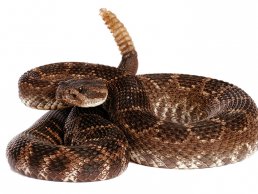
Physical Appearance of a Rattlesnake
Rattlesnakes are long, limbless reptiles that can grow up to eight feet in length. The venomous pests have thick, scaly bodies and triangular heads. Coloration and markings vary by species, but rattlesnakes with gray, black, brown, olive, or yellow scales and banded, diamond, or spotted patterns are most common. As their name suggests, these snakes can be identified by the rattling sound made by the segmented joints on the ends of their tails. However, newborn rattlesnakes and some adults do not possess this feature.

Rattlesnake Habitats
Although abundant throughout much of the southwestern U.S., four species can be found east of the Mississippi River. Rattlesnakes frequently inhabit deserts, swamps, plains, meadows, and hills. They typically den in concealed areas like inside animal burrows or under rocks and debris. Rattlesnakes hibernate through harsh winters, but can be seen laying out in the sun during warm weather. With an appetite for rodents and other small pests, these reptiles congregate on farmland or near neighborhoods where they are likely to find prey. Rattlesnakes can look like other, nonvenomous snake species, like gopher snakes or eastern milk snakes, which enjoy the same habitats.
Problems Caused by Infestations
Rattlesnakes often warn intruders of their presence by hissing or producing their notorious rattling sounds. However, snakes that feel threatened or in danger are prone to bite regardless. Venom from rattlesnake bites is seldom fatal, but symptoms like severe pain and muscle or tissue injuries are potential problems. Homeowners should avoid handling or attempting to trap rattlesnakes near homes and instead look to the experts at Critter Control for safe identification, removal, and control.